|

THE ANOMALIST - 1
Summer 1994
from
Scribd Website
For the most part
Mario Pazzaglini
walks confidently through life.
As a clinical psychologist with a
private practice in Newark, Delaware for the past 22 years he is
certainly on firm footing. During this time he has also been a
clinical instructor at the Jefferson Medical School. And at times he
has been on the adjunct faculty of the department of psychology at
the University of
Delaware. But sometimes, by his own admission, Pazzaglini tip-toes
through territory most would consider "unacceptable." One such area
is "alien writing."
His interest in the subject dates back more than
a decade. During this time he has collected samples of writing which
people claim to have obtained from alien sources by various means.
In 1991 he took a first stab at organizing this often vague, very
complex, and always controversial material in a book called
"Symbolic Messages - An Introduction to a Study of Alien
Writing."
This privately published volume is both an introduction to
the study of writing and other symbolic systems, and a look at how
"alien writing" fits into the subject. He also presents these found
alien symbols as a model for attempting to understand alien
intelligence itself.
Pazzaglini has also treaded cautiously through
the subject of street drugs.
Since about 1967 he has done
ethnographic studies on neighborhoods and the kinds of drugs they
use and has traveled all over the world in the process. He is now
putting together a book on the subject. Its glossary contains
entries for about a thousand different street drugs. His interest in
the subject stems from a fascination with images - the same subject
that eventually led him to study "alien writing."
In 1969 Pazzaglini
ran one of the drug clinics at Woodstock.
Patrick Huyghe
How did you come to be interested
in "alien writing"?
Pazzaglini: I can trace it to my basic interest in internal
representation. Out of that grew my interest in images. Out of
that grew my interest in symbols. And out of that grew my
interest in different forms of writing, in other words, how
ideas were put down in symbols. Alien writing is a subgroup of
that last interest.
I've been doing work on images since about
1965, but this particular collection started about 10 years ago.
The subject sort of appeared as a question in my head. I was
reading some
books on UFOs and wondered about the whole issue of
physical traces. Work had been done on marks on the ground, UFO
nests, and such. A couple of articles and books mentioned that
there was writing and symbols and I was curious as to what they
would look like.
So I wrote to these people and began asking
them for samples and that sort of took off.
Where did most of your samples come from exactly?
Pazzaglini: There were three main sources. One source was
directly from the people, the people who feel that they are
contactees or those who feel that they are abductees. I've also
gotten some from various UFO authors;
Budd Hopkins looked at
what I have and he agrees that some samples look similar to what
he has collected.
My third source was a large stroke of luck; I
got them from the estates of
George Williamson and
George Adamski.
These are interesting for me, because these people were
part of the contactee movement in the early 50s late 40s, before
the field was, in a sense, contaminated.
I also knew from my other work that there were systems in
history like this, such as the one produced by Dr.
John Dee, the
court astrologer to Elizabeth the First, and Edward Kelley. The
story goes that a spirit appeared to them, a being of light, who
dictated to them an entire system. I have a copy of this
manuscript.
It's a language, an alphabet, and an entire magical
system.
This system was then used at the end of the 19th century
by
McGregor Mathers in formulating
the Golden Dawn and the other
organizations that grew out of that body of knowledge. That
system is known as Enochian and is still in use by various
magical and ritual groups. And there are other systems like
that.
The writing on the golden plates of the
Mormon Church is
another example.
There is a whole history of such
material.

Sample from a
1987 abductee.
Too small a
sample to work with, but belongs to the dot and line category of
scripts.
Usually these are
alphabetical scripts.
(All examples
from Mario Pazzaglini's Symbolic Messages.)
How far back does this history go?
Pazzaglini: There are traditions in Egypt concerning the
god
Thoth, who supposedly devised writing and gave the symbols to
the people. Other examples includes Oannes, a half-man,
half-fish who did the same job for
Sumeria as Thoth did for
Egypt.
Then there's
Dogon who did it for the Philistines and
Quetzalcoatl who did it for the people of Central America. In
fact, I went to Mexico because I heard rumors of a cave at
Juxlahuaca in the state of Guerrero where there are frescoes
dating from a thousand to five hundred BC in age. And reportedly
there was a picture of a feathered serpent giving a symbol to an
Indian.
So I went there, and after an incredibly hideous day,
made it into this cave and there it was. I'm not making many
conclusions out of this, but there is a very strong mythological
structure throughout the world of people coming from someplace
else and handing symbols to people.
The history is in our
mythology, too, because Moses got the
Ten Commandment written on
tablets by the hand
of God.
What was the script of the Ten Commandments?
Pazzaglini: No one knows what these symbols looked like but they
were clearly thought to be extraterrestrial in origin. The
earliest version we have is in ancient Hebrew, which, in
historical terms, is a rather recent development.
So it
certainly wasn't in that script.
I see in your book that some samples are copies of symbols
that people remembered seeing on a craft. Others came from a
piece of paper or a book they were handed by the aliens.
Pazzaglini: Anything you can think of I have an example of. In
other words, there are people who copied symbols directly off of
objects and this is what they are giving me.
There are people
who are given books, like
Betty Andreasson.
They have the book
for awhile, and sometimes they can copy down what they saw, or
they sort of get the gift of being able to receive more script
by telepathic means.
Channeling?
Pazzaglini: Yes, though I've scrupulously avoided that term all
through the book at the expense of an awkwardness in language.
It's such an overused word.
But yes, at one extreme are people
who just channel writing.
How many examples of alien script have you collected in the
past decade?
Pazzaglini: I probably have nearly a hundred. What's interesting
is that if you talk to people about the verbal content of their
channeled writing and ask them to send you a sample and use it
for publishing purposes, they are usually pretty happy to go
ahead and do that.
But the symbols people hold very close to
themselves, for whatever reason. They seem to be more personal.
So I've had a hard time obtaining permission to use symbols of
the people who received them. Then there are the researchers who
collect this kind of material but who refuse to show them to
others so as not to contaminate the field.
I can understand that
because the field is so incredibly confounded already.
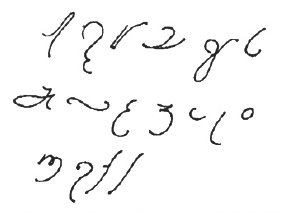
Example of a cursive script from a 1992 Contactee.
"I received
this in my mind after my first contact" (CE II ).
"It's both
technical and religious... how to manipulate minerals and
light."
Does any sample stand out as particularly bizarre?
Pazzaglini: There's one I received recently. The writing
appeared on lumber and I saw the boards.
I'd really have a hard
time believing this if it hadn't come from such a credible
person, a person working at a lumber supply yard, who gets
injured because these boards fall on his head. And on these
boards are all sorts of symbols. Is there a wood burning set in
the sky? I don't know.
He's baffled and scared and doesn't want
to talk about it much anymore.
And you don't find these people psychopathological?
Pazzaglini: No. And if I can brag a little bit, I know. Because
I've dealt with all sorts of pathology and he was dead normal.
That's one of the questions in my head all the time. It's not
that I would exclude someone who is psychotic. But I certainly
want to know that.
Or if they are multiple personality, which
would be even more to the point, I'd want to know that. He
showed no signs of psychopathology, nor did his family make any
complaints that would indicate any kind of pathology. Then
there's the fact that he wants to push it away, which is fairly
normal, and not talk about.
It just doesn't fit into his life.
In general almost none of the people submitting samples has any
significant psychopathology.
How about hoaxing?
Pazzaglini: There is a lot of that. And it's of two kinds.
There
is unconscious hoaxing and conscious hoaxing. I have a few which
I've been able to trace down myself because I'm lucky that my
first interest is in writing itself. I have a large library on
writing and symbol systems. So if I receive a sample I can go
look for it, and I know the library well enough to usually find
it, if the writing has been copied. In a few instances I have
found exact copies of rather obscure languages.
They're not
always incredibly obscure. One turned out to be from the Book of
Mormon. But few Mormons would even recognize it, as only two to
five percent of them have actually seen the script. It's like
the number of people who have actually read the Bible. Another
sample turned out to be from the
Phaistos Disk.*
[* Found in Crete
in 1908, this artifact has been dated as no later than 1700 BC.
The 242 signs impressed on both sides of the disc remain undeciphered, as they bear no resemblance to the ancient
pictorial script of Crete or to any other hieroglyphic form of
writing.]
That's fairly obvious conscious hoaxing.
What are some of the features of genuine "alien writing"?
Pazzaglini: I started at the other end of that question and did
a study to see what the features would be of blatantly made-up
writing.
Yes, you ran an experiment on that. Tell us about it.
Pazzaglini: I've done this a few times actually. I take a group
of people and give them simple instructions.
Because in my
scientific framework there is one set of rules, but if I broaden
it slightly I'd have to control for
ESP and such, which in terms
of an experimental paradigm gets fairly crazy quite soon. So
I've kept it simple. What I've done in these pilot studies is
take a bunch of people, put them in a relaxed state, and asked
them to imagine what an alien alphabet might look like.
I ask
them to get a picture of that in their heads and, when it forms,
to write it down.
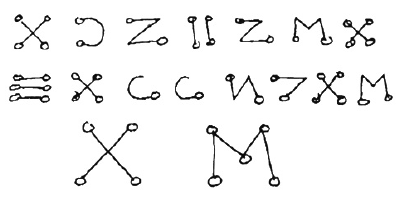
"Angelic-music"
writing from circa 1944-45, done at that time by a
child 4-5 years old.
"They gave it to
me; it just came into my head."
You asked for an alphabet rather than a script?
Pazzaglini: I said alphabet because
I wanted to control for whether they produced an alphabet, or a
syllabic system, or a pictographic system. But a handful of
people didn't follow the directions and produced systems that
actually were not alphabets.
And believe it or not, some of them
then refused to give me permission to write them down, because
they said that they had actually gotten them from alien beings!
Really? How many examples like that did you get?
Pazzaglini: About 5 out of maybe 50 people, which is a pretty
high percentage, however this group may not have represented the
average population. And later on other people came to use the
process, incorporating it into their own method of adjustment to
life and coping. They would turn to whatever source that was and
ask it questions; should I do this or should I do that?
A
handful of these people have almost totally integrated that
process into how they function. That's pretty weird, but it's
not unknown.
So anyway, the characteristics of the blatantly made up
alphabets - whatever that means now because the definition has
become a little shaky here - are that people seem to be limited
in how they think about making up symbols. They tend to either
regress into scribbles, or into shapes you would expect like
triangles, circles, and other sort of archetypal perceptual
forms.
They also tend to run out of flexibility and begin
repeating basic forms. That's clearly a characteristic of a made
up alphabet.
Then, when I broadened it and told them not to make
up an alphabet but to make up an alien symbol system for
representing thoughts, most people produced alphabets
anyway, many of which resembled the English alphabet.
So now what are the characteristics of those you consider
possibly genuine?
Pazzaglini: First you need a large sample to even begin to make
that kind of judgment.
One sample I have is about 500 pages and
it meets the first characteristic, which is that it should have
a limited number of symbols. This one has about 60 symbols,
which means it's most likely a syllabic system. The second
characteristic is that the symbols must be repeated throughout
the text. And in this sample things repeat in different
contexts.
So this begins to look like a language with the
characteristics of having a sound representational system, some
sort of definition into words or thoughts, whatever they may be,
and a grammar, meaning that there are repeating patterns.
Who produced these 500 pages?
Pazzaglini: It comes from a well-known
abductee whose name would
prefer not to mention. Her material looks very much like those
from two other abductees who also have had really complex
experiences. The writing looks like Greg shorthand.
But unlike
shorthand its structure appears syllabic, like the structure of
Sanskrit or Tibetan. In syllabic systems about 60 different
symbols are involved and each one represents at least one
consonant and one vowel. English, to put this in perspective, is
an alphabetic system, which involves less than half as many
symbols and where each one equals a single letter.
Now I have other items that look really alien, but I may only
have 10 to 12 symbols so they're hard to judge. I just got one
from Poland, for instance, that's very much like this abductee's
but you have to sharpen up all the curves, you have to sort of
geometrize this abductee's alphabet.
It's another fairly complex
system with about 68 separate symbols.
So it falls within the
same framework.
How many types of alien writing have you found?
Pazzaglini: In the book I show three types, a geometric type, a
dot-and-line type, and a script-like or cursive form. Now I have
another one, which comes from a crashed-saucer witness, and he
produced symbols for me that he remembered seeing on the pieces
as a child. What's interesting there is that what he retrieves
consciously is better than what he retrieves hypnotically.
I
don't have any other samples that look like his, so in that
sense, it's truly alien. It looks like nothing else.
After eliminating the hoaxes and those without enough
material, how many promising samples are you left with?
Pazzaglini: About a handful. Out of those three share some
symbols, but then it's like comparing your handwriting and my
handwriting and someone's printing.
If you were totally
unfamiliar with the language and if the language was more
complex than ours, it would be pretty hard to tell if its the
same thing.
What are those symbols on the cover of Symbolic Messages?
Pazzaglini: Those two symbols come from a 3-to-5 year-old boy.
They are his "lead symbols." In other words, he looks at those
symbols to get back into the mode of pulling more of the writing
out of him.
What's interesting is that he produced page after
page of this stuff between 1943 and 1945. And luckily his
parents saved some of it. Turns out it looks like a known
alphabet from late Middle Ages, about 14th to 15th century. It
looks exactly like what's called the Celestial Alphabet, a
ritual alphabet very similar to Enochian in function.
Whether
that's a coincidence, God only knows.
How could theories of unconscious processing explain alien
writing? How could it be "psychological noise," in other words?
Pazzaglini: I studied with Roberto Assagioli in Italy and he was
a friend of Jung's. As part of his theoretical framework, he
believed that people had subpersonalities that could act fairly
autonomously at times.
These personalities or complexes had
access to neurological and psychological processes that we don't
have direct access to, except perhaps in some sort of creative
state. So in his therapeutic process, a system called psychosynthesis, you actively invoke various pieces of a
personality (subpersonalities) and reintegrate them into a
person's functioning.
It's possible to do this. I've done it and I've taught people to
do it. It's essentially the same as teaching people to channel.
First you get people into an image and you treat pieces of that
image as a representation of a certain subpersonality.
Then you
name it and form a relationship with it by talking to it, saying
"thank you for being here" and such, and eventually you can get
it to do tricks. And one of the tricks they will do is to
produce alphabets. They'll do anything that you want them to do.
Now whether those things become operational, or mean anything in
the real world, is another whole story.
Did your clinical practice have any influence on your alien
writing work?
Pazzaglini: Yes. One of the sources for the interest is that
I've always worked with really ill people, with extremely
psychotic patients. And in my career there have been about a
handful of patients where I felt like something was going on
that we just don't understand at all.
Three quick examples.
I
had a 16-year-old boy from downstate Delaware who was Amish. He
came in writing in a totally alien script. This is 1968 and I
didn't even know the concept then. But because I was curious I
searched and searched and finally found the script and it
happened to be one of the magical medieval scripts.
Now again,
how that gets explained, I have no idea; he had no previous
contact with this material.
I had another kid, also 16, an LSD user, and the language in
which he spoke was Old High German. Now how he figured his way
to Old High German, God only knows, but he did. He didn't speak
it well, but he did give me real words. My third example came
from a woman who was found on the street preaching, but no one
could understand her because she was speaking a language that
was really an amalgam of Latin, Greek, and, I think, Slovanic.
After I got her to write it down and looked at it, I began to
make some sense out of it. Now the content of it was a bit like
a science fiction blurb, but it was interesting.
She had only
gone through the eight grade; she knew none of the languages she
used but of course pieces of Latin and Greek are buried in our
own language.
These appear to be more suggestive of reincarnation rather
than alien writing.
Pazzaglini: I've thought about that, but if I added
reincarnation to the mix also, I'd be utterly lost. So I've
tried to keep my official thinking on the subject as simple as
possible. But I should add this footnote: I studied with Tibetan
lamas for about 20 years because I wanted to understand how
other cultures have thought about how the human head works
inside.
They have a tradition called
Termas. These are what they
call Found Teachings. And these can be found in people's heads,
in other words, people will have a dream and write down a
teaching in maybe a foreign language, or maybe a ritual form of
Tibetan, or maybe a totally alien script.
What I'm saying is
that they consider the phenomenon to be separate from the issue
of reincarnation, except that some of the "beings" that have
gone on and who stay near the Earth as protectors will sometimes
act as transmitting entities. That was interesting to me,
because I wondered about that question, too.
Here was a culture
that believes in reincarnation, but did not use that explanation
for those kinds of teachings.
Do you know of others who have collected this kind of
material?
Pazzaglini: Obviously Adamski and Williamson did. They collected
these writings from all over the place. The oldest example
Williamson had was from 1937, from pre-flying saucer days, in
other words.
But the story involved a craft that landed in a
field. When the farmer went out, they handed him a piece of
paper and there were symbols on it. And I have that drawing by
the original person. It's really a nice piece. There are a
couple of the older UFO organizations that have files with this
kind of material. But it's rare, actually. And for some reason
people haven't been very interested in it.
I would think it's a
nice piece of evidence and, if nothing else, a fairly startling
phenomenon.
You make the argument that the study of alien symbols and
scripts might be a useful way of studying alien intelligence.
Pazzaglini: Yes, because the assumptions are - and they are both
staggering - either that alien intelligence grows out of similar
biology or that it's totally different and then we probably
can't even think about it because we are fairly circuit bound.
I
can make up a lot of good stories about what that intelligence
might be like. But there's one type of writing that's very
interesting and there are actually systems like this on Earth.
That's where the act of writing the symbols themselves actually
constellates the neurocircuitry in such a way that the brain
becomes receptive to the patterns being drawn and the meanings
that they contain at that particular moment.
That's a real
interesting concept and very different than the system of
writing we are accustomed to seeing.
Is it like an automatic translation then?
Pazzaglini: Yes, it's like a recording. That's very much like a
sigil. Certain sigils were meant to act that way. In other
words, if you take your finger and trace over the sigil it
produces a concomitant psychological and physiological change
within the person.
In fact, in biology there are systems like
that; they are called
entrainment systems.
What's entrainment?
When you and I stand in front of each other,
before we even talk, in the first few seconds as we look at each
other, we trade information; we interlock by means of our
perceptual systems. It's possible to make diagrams that do the
same thing, that "arrange" us perceptually. I've actually played
with this, I've made such diagrams.
Certain kinds of diagrams
actually produce minute physiological and psychological changes
inside of people. Sometimes these are called sigils. In Eastern
iconography they are called yantras, or mandalas.
That's what a
yantra is. A yantra organizes physiology so that psychological
processes of a certain nature can be evoked more easily.
The
process of entrainment answers the question of why ducks don't
have sex with cows. And why ducks don't bump into each other.
There are innate wiring systems for perceptual recognition and
information transfer. It seems like a fairly important question.
People have dealt with the behavioral and social aspects of it,
but I'm really interested in the mechanics of how it happens.
The brain spends a lot of money, so to speak, developing those
systems. And so in evolution the development of these
entrainment systems has been very important. For the auditory
system, these were lateral line organs in fish, and those became
the inner ear and the auditory canal in primates, so the lateral
line-auditory-vestibular system has always been used as an
orienting sense.
And of course, mantras, which are the auditory
equivalent of the yantra, operate on this system. They organize
physiology so certain psychological processes can take place
more easily. So I've done a lot of thinking about that. Some of
the weirder thinking I can't even put into words yet because
it's hard to conceive of how an alien organism would occupy this
kind of space and maneuver in it and not be of the same system
as we.
And how would it communicate to us?
One of the things the
UFO literature makes obvious is that aliens apparently can speak
the language of whatever country that they appear in, English in
America, Portuguese in Brazil, Spanish in Mexico. So are they
multi-lingual or do we receive in our own language or is it all
just in our heads - is outer space really inner space?
That's a
piece of epistemology that you could set three philosophers on
for an awful long time.
How about possible translations of the alien writing?
Pazzaglini: The abductee who produced the 500 pages of material
was still in contact and the aliens seemed to be of a frame of
mind that they would answer questions. So I began to ask them
questions about how I might go about translating it. That
project is still in progress. I did one thing as an exercise.
After making certain assumptions - for instance, assuming that
it's a syllabic script, that the major symbols are consonants
and the minor symbols are vowels - I came out with a tentative
kind of transliterations and/or translations. But I'm so far
down the assumption line that I'm probably standing on gas. But
eventually I got one sentence to actually read out somewhat
logically if, in fact, it is a sentence.
It said something like,
"In order to make light solid, show it to the moon."
I arrived
at that on my own.
But when I asked the abductee what this
passage was about she said it was about how to make light solid.
So she has an idea what these things refer to.
Pazzaglini: Oh, yes. There is another phenomenon here and that
is very often people who have this material will have a gut
feeling of what it's about although they can't translate it word
for word.
You can experience this yourself if you go into a
church where people speak in tongues. After you are sitting
there for awhile, although you don't understand a word they are
saying, you become sort of entrained to them and some of the
meaning begins to bleed through. I've done this.
It's a great
experience.
Have you ever talked about your collection of "alien writing"
samples to the highly controversial former Harvard University
marine biologist Barry Fell who claims that Old World writing
can be found throughout the Americas prior to 1492?
Pazzaglini: Yes, I did show it to one of his "followers" and he
has no idea what it is. It looks like nothing he's ever since
and he's seen a lot.
I got a few of these samples in the
mid-1970s and though I hadn't done anything with them at the
time, I was every interested in what he was doing because I was
interested in languages. But what happens is if you take a
pencil and paper and scribble for 10,000 years you are bound to
repeat a few things. So you can look at pieces of alien writing
and say this looks like this and that looks like that.
He had
seen one symbol before. It looks like a crescent with a line
through the middle. That appears in alien script after alien
script after alien script. It's a very stable element. Its also
common in the Middle Ages as a sign for different kinds of
alchemical processes. It looks like a backward "e."
But as a
complete form, the alien writing did not seem familiar to him.
Any final thoughts on the subject? Any way to ever hit
paydirt in this work?
Pazzaglini: I try not to keep that framework in my head.
That will spoil it I think. I don't think I know enough to say
more. I can recognize some of the patterns now. I can recognize
if a script looks like another script. I can do a few simple
tricks. I'm going to continue collecting and I would like to get
a computer program so I can put all the symbols into a pattern
recognition system.
But otherwise I try to keep away from what
one person calls "the lust of results."
For me, premature belief
only destroys perception of the possible. Belief excludes and
it's too early to do this. I am not sure even if this is an
entirely external or internal phenomenon - or perhaps a mix.
It
could be that we humans, as a group of beings, can elicit from
reality what only begins as our needs, thoughts, and wishes.
-
Could there be a psychoid element, as Jung puts it, that is able
to materialize what is internal?
-
Or are we really being spoken
to through the noise and chatter of this material?
-
Is this
something a process, purely within ourselves, or a complex
message system from the outside, from an unknown external
source?
I'm not sure.
Alien Writing
from
UFOMystic Website
Part 1
January 09, 2007
In 1994, in the course of publishing my old zine, “The Excluded
Middle,” I read an interview in the first “Anomalist” magazine
(above report) with
a clinical psychologist who specialized in the study of purported
“alien writing,” that is symbols that human recipients claim are
products of a non-human source.
This study was carried on without the
general knowledge of his colleagues, which he surmised might have
affected his private practice and his work with severe psychotics
and drug abuse cases.
Before I could find out how to get in
touch with him, he sent me a copy of his self-published book
"Symbolic Messages - An Introduction to a Study of Alien Writing" with a letter stating,
“I knew you needed to see it.”
Dr. Mario Pazzaglini was a
remarkable man, as I was to find out over the next few years until
his untimely death in 1999.
I only met him once, at the 1997 Roswell
bash. We eschewed the parades and some of the more boring lectures
one day and went thrift-store shopping. Most of our talks were over
the phone, and he actually provided some much-needed free therapy
when I mentioned some things that were going on in my life at the
time.
In 1970, he was at the Woodstock music festival, helping to run the
“bad trip” tent along with a few Tibetan Buddhist friends when the
hippies couldn’t handle their acid.
He had been a regular in the Washington
D.C. insider circuit for a few years in the mid-1960s, when he was
still in college majoring in physics and mathematics.
"He would have made a great
physicist" says his brother Peter.
In the late 1960s, he had changed his
mind and entered the graduate program in psychology.
He earned his doctorate from the
University of Delaware in 1969, and lived in the small town of
Newark, just a couple of miles from U.D. for the rest of his life.
He later became an expert on the problems and cures of drug abuse,
serving on several committees and panels for the state of Delaware,
and in his psychiatric practice, specialized in treating the
severest of the mentally ill.
Like everything else in the late '60s,
the field of psychology was undergoing an upheaval as newly-minted
doctors began to explore anything that would make the job of healing
faster and more rewarding for the patient.
"Western culture tries to keep
everything fragmented and separate, and one of the things all of
us were trying to do was introduce connectedness back into the
process" recalled Pazzaglini's longtime friend and psychiatric
practice partner Dr. Paul Poplosky.
"I think that's where some of his
other interests came into play."
Those "other interests" included a
cornucopia of esoterra; alchemy, cabbala, tarot, and a heaping dose
of numerology.
He also made enough of a splash through
well-concealed back channels that our buddies in the ubiquitous
black helicopters occasionally shadowed him. He compiled a magickal
and symbol system of his own devising which may never be cracked. In
short, he may very well have been a modern-day Magus in the guise of
a mild-mannered psychologist from Delaware.
This was his perspective when examining
the subject of UFOs.
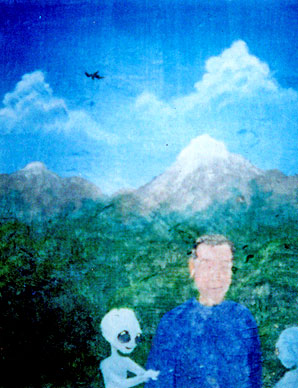
Self-portrait of Pazzaglini with “friends.”
He attended a conference on UFO
abduction at M.I.T. in 1992 and presented his research to the
leaders in the field, but few of his friends ever knew about it.
Most of the leaders in the abduction field basically ignored the
subject. Almost no one knew he had notebooks filled with examples of
strange symbols.
Hundreds of his paintings and drawings
filled his home.
"I believe in his next life, he'll
be an artist" says his brother.
Part 2
January 26, 2007
Someone out there has been writing us letters for a long time.
Strange symbols and printed languages
turn up regularly in UFO encounter experiences. Police officer
Lonnie Zamora glimpsed a strange
crescent-and-arrow type design on the side of an egg-shaped craft at
Socorro, New Mexico in 1964.
The account of Jesse Marcel,
Jr. includes pieces of wreckage that his father, Major Jesse
Marcel, brought home to Roswell in the early morning hours of July
8, 1947 inscribed with symbolic writing that, if genuine, bears
little comparison to earthly communication.
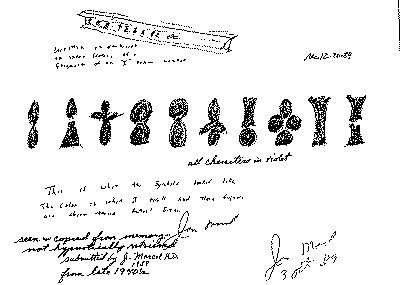
Jesse Marcel, Jr.’s drawing of Roswell wreckage symbols.
"Alien writing" can literally change history.
The
Mormon faith is based on
translations of strangely engraved golden plates that founder
Joseph Smith claimed to have dug up after a divine visitation in
1823. As for the authenticity of "mentally received" messages, there
is reason to believe that at least some of the symbols and symbol
systems described do not originate from the psyche of the
participants.
One of the difficulties in verifying the authenticity of an alien
script is that if it resembles an earthly language or known
terrestrial symbols, is it necessarily a "true" one?
Perhaps the reason for this is that all
input into a human consciousness is filtered through an individual's
learning, experience, culture, and prejudice, and the messages must
necessarily be rendered in a form that is understandable to the
receiver as well as others. The flipside of this reasoning is the
obvious possibility that the receiver might be delusional,
hallucinating, or simply hoaxing the account.
While it takes little skill to devise an
alphabet with a one-to-one relationship to the experiencer's native
language, a representational pictorial symbol system or one with no
discernible grammar or syntax (at least one which seems to possess
an internal logic) is more difficult to fake.
Humans receive alien writing in many ways.
Some say that the symbols come from
"angels" or "teachers." By far the most common method of reception
is by "channeling," but the messages can also be the result of a
close encounter wherein the participant sees and remembers symbols
or languages shown to him while wandering about inside (or inside
what is perceived to be) an extraterrestrial craft.
An early example is the case of
Herbert Schirmer, who in 1967 claimed to have been taken aboard
a ship near Ashland, Nebraska. On the uniforms of the beings he
encountered was a symbol that resembled a winged serpent. This theme
is obviously not exclusively extraterrestrial, as it was known to
the Greeks and Romans, as "dragons" in Chinese and European lore, as
well as to the new world cultures of Central and South America.
There is the possibility that Schirmer
may have incorporated it (consciously or not) into his account. An
interesting sidelight is the fact that the Mayan culture held the
belief that
Quetzelcoatl, the feathered
serpent, had taught and bequeathed to man a system of pictorial
writing.
Dr. Mario Pazzaglini made a 16 year study of examples and
possible sources of alien writing, and chronicled them in his book,
Symbolic Messages.
He collected hundreds of samples and
classified them into distinct categories:
-
Alphabetic: consisting of 20-30
symbols, where each symbol is a consonant or vowel
-
Syllabic: usually 50-60 symbols,
where each symbol represents a consonant/vowel combination
-
Ideographic: Usually 500-600
symbols, where each symbol represents an idea or word
-
Symbols: Consisting of single
and complex insignia types.
These categories must necessarily derive
from a human understanding of representational visual systems, and
in fact most claimed alien writing examples fall into these
categories.
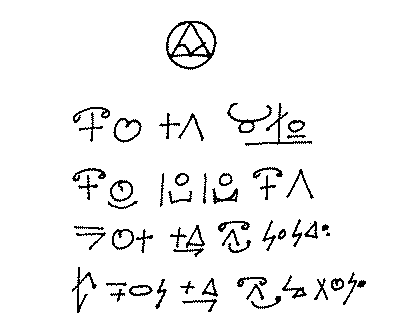
aUI language taught to John
Weilgart (he claimed) by spacemen.
Pazzaglini conducted a limited
experiment wherein participants were asked to conceive their own
"alien language."
The results without exception showed
that, left to their own devices, people tend to concoct alien
alphabets that bear a one-to-one relationship to their native
language.
In the realm of the written word, one of the earliest concrete
examples of what was purported to be an extra-human communication
was channeled by medium Edward Kelley and his boss,
Elizabethan Court Astrologer and all-around magician
John Dee, from 1582 to 1589. Dee said that an "angel"
had dictated to him (through Kelley) a system of symbols to be used
in a ceremonial context, and would provide the user with a higher
understanding of magical and alchemical concepts than human-based
writing.
The system was called "Enochian," and is
still in use by occult practitioners today.
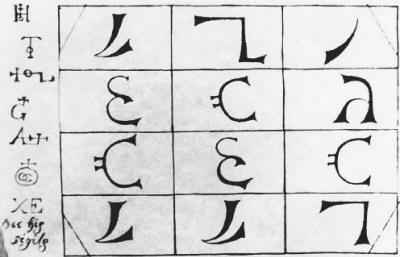
Enochian symbols.
It communicates concepts through the
juxtaposition of symbols and their relationships to each other, and
does not appear to be derived from any written language. Enochian is
claimed among its adherents to affect the reader/user on important
subconscious levels as well.
This aspect of alien writing has also
been mentioned by UFO contactees and abductees.
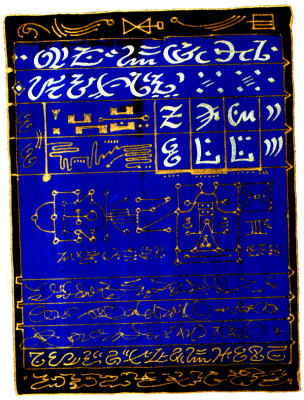
Alien writing channeled by Pazzaglini.
Pazzaglini’s own alien writing doesn't
resemble anything else that UFO witnesses have reported, with one
exception.
There seems to be a spiritual, if not
graphic kinship with the scribblings of
Betty Andreasson
and her family, and this may explain the fascination he had with
this case.
Andreasson, whose abduction experiences
were chronicled in the Andreasson Affair books by Raymond Fowler,
has produced hundreds of pages of a cursive script that almost
defies analysis.
After comparing Andreasson's drawings to
various medieval alchemical symbols, Pazzaglini was able to
translate one possible sentence out of hundreds.
It read:
"If you want to make light solid,
show it to the moon."
While this probably makes little
practical sense, it does make for a beautiful sort of poetry.
Pazzaglini once told me that he was in contact with leading
abduction researchers who promised to send him examples of alien
symbols, but he never got them. Perhaps it was because they wanted
to keep the symbols secret to verify the authenticity of future
claims, or maybe it was simply their egos getting in the way.
Another study of alien writing has yet
to be published, which is unfortunate. Pazzaglini had to
self-publish his own monograph.
Admittedly, the study of alien
writing would make little sense to a publisher with an eye on
the bottom line, but as a contribution to an understanding of
extra-human experience, it should be welcomed.
Asemic Texts = Alien Writing?
by
Greg Bishop
July 21, 2009
from
UFOMystic Website
My intention in this post is to examine
ideas and engage in a bit of freeform speculation, while not
claiming that any specific statement is “true.”
Yesterday, Mac Tonnies linked a site called The New Post
Literate from his blog that showcases and examines an art style
called “asemic writing.”
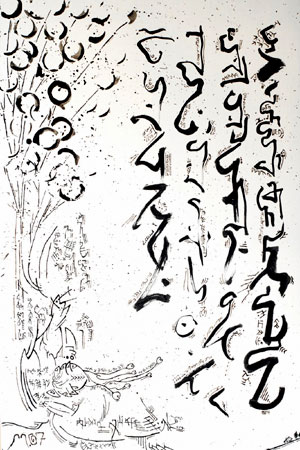
A Wiki entry describes the term:
Asemic writing is a wordless open
semantic form of writing. The word asemic means “having no
specific semantic content”.
Illegible, invented, or primal scripts
(cave paintings, doodles, children’s drawings, etc.) are all
influences upon asemic writing. But instead of being thought of as
mimicry of preliterate expression, asemic writing can be considered
as a post-literate style of writing that uses all forms of
creativity for inspiration.
Some asemic writing has pictograms or ideograms, which suggest a
meaning through their shape. Other forms are shapeless and exist as
pure conception.
Where does this put us with regard to supposed “alien” writing,
where the percipient almost always assumes that symbols witnessed do
have some “specific semantic content?”
Asemic writing (at least as it is
postulated by artists working in the genre and other interested
parties) may have no overt meaning, but the creators are apparently
trying to communicate something, even if it’s just the voice of
their subconscious bubbling up though the conscious mind, through
their hands, and onto the page, canvas, or computer screen. This is
one of the main ideas behind modern and post-modern abstract art.
Artists use color, line, and shapes to
communicate or examine how we interpret and react to basic visual
inputs.
Dr. Mario Pazzaglini’s rare book "Symbolic Messages - An
Introduction to a Study of Alien Writing" may be a fair commentary
on both Asemics and aliens. For many years, Pazzaglini worked with
people who either claimed physical or mental contact with ufonauts,
or had “channneled” messages and scripts from otherwise disembodied
sources.
Symbolic Messages is composed of
about half commentary written by Pazzaglini and page after page of
words in alien, angelic, occult, or apocryphal languages.
Pazzaglini acknowledged that humans are perfectly capable of making
up their own inscrutable languages.
One of the best examples given is
The Voynich Manuscript, a
handwritten book from the 15th or 16th century which has so far
eluded any efforts at decryption.
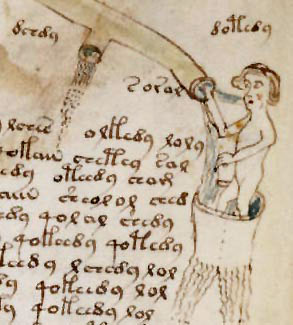
Detail from Voynich
manuscript
Looking at the illustrations in
Symbolic Messages, it is difficult to determine what is being
communicated, if anything, but one example, simply titled “A Cursive
Script, 1990″ was described as working on many levels other than
just simple information transmission from one mind to another.
The graceful squiggles were described (by the recipient) to
Pazzaglini as attempting to communicate a message on several levels.
As he explains:
[this is] an interesting script
where it is conjectured that it represents a summary of:
1. The internal state of the
sender
2. The intended internal state
of the receiver
3. The state of the relationship
4. The message itself
Therefore, there are no, strictly
speaking, repetitions of symbols but a line-symbol of
interrelated states and message. This is a good example of a
totally foreign (to us) kind of writing system; it would be
essentially untranslatable.
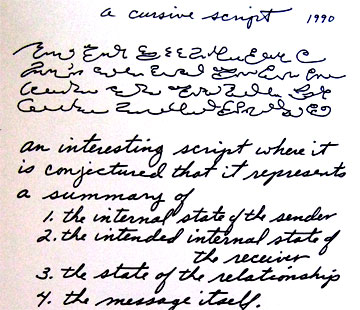
He adds at the bottom of the page:
In another example of this type, a
symbol was “decoded” by tracing it out and thereby “receiving” a
message – ”like playing a record.”
Used in this way, written language may
be much like a living (although primitive) intelligence itself,
interpreting nuances of emotion and shades of meaning to communicate
much more than just a mere message.
Strangely, this is also places it in the
same general category as the widely denounced
“Caret”
(Commercial Applications Research for Extra-terrestrial
Technology) symbols, touted by the anonymous source “Isaac” in 2007.
The source claimed that the symbols
themselves were part of the design of an alien device, and activated
the mechanism on which it was printed, which he and a team of
researchers attempted to back-engineer in the 1970s.
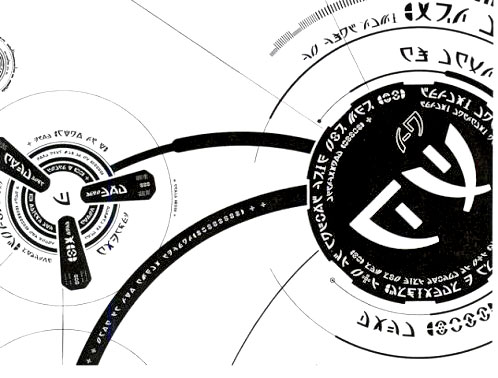
CARET symbols
Could mere symbols be part of an
interface between a machine and its creator or user?
This idea resembles (and in some ways
surpasses) the philosophy behind many occult writing systems,
particularly John Dee’s channeled language of “Enochian,”
as well as others like magical symbols called sigils and even
designs used in voodoo. The symbol itself and the act of writing it
is supposed to activate forces to be used by
the magician.
This magical sigil, for example was created by an occultist for a
specific purpose which was described as,
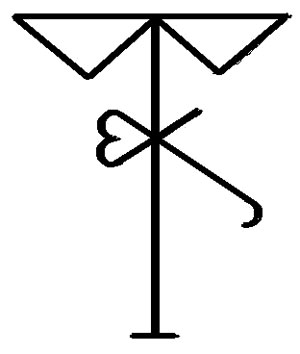
…a means of exerting my will to
achieve a specific end (in this case, the return of stolen
property)… The idea is to turn conscious desires into
unconscious events, allowing that secret daemon inside our
skulls to affect reality on a subtle level and, presumably,
satisfy your encoded desire.
Are disembodied “aliens” using symbols
to exert their wills on unsuspecting
UFO/abduction witnesses?
It is an idea that has been suggested by
a few researchers. Witnesses have also claimed that “aliens”
interfaced with their craft and other devices on a deep mental
level.
While in a hypnogogic state, I once
imagined endless columns of numbers that were somehow arranging to
plot against me! Maybe one of the asemic artists will wake up some
morning with a hulking “something” in their bedroom awaiting
instructions!
More likely though, we are dealing with
a phenomenon at the edge of our understanding which may be
one more key to a better examination of supposed non-human
intelligence, and one way that they may be sending us garbled
messages, or perhaps the “messages” are just etheric junk to
which we assign our own meanings without realizing it.
William Burroughs said that,
“We may be tuning into a universal
message with faulty radios.”
At the very least, a better
comprehension of this phenomenon may also bring us a step closer to
an understanding of how our minds interpret symbolic input.
P.S.: I am still
trying to get permission to reprint "Symbolic Messages," as well as
some of Pazzaglini’s examples of his own channeled writings as well
as those of others.
Video
Radio Interview to Dr. Mario Pazzaglini (extract)
- Infinity Factory
by Richard Metzger
October 04, 2001
from
OldDisinfo Website
Richard Metzger interviews the late Dr. Mario Pazzaglini,
the author of "Symbolic Messages - An Introduction to a Study of
Alien Writing".
Dr. Pazzaglini was investigating the possibility of Alien writing by
studying hundreds of artifacts and interviewing individuals who
claimed to have been contacted by alien intelligences.
He presents a
very balanced, rational, and informed view about the escalating
reports of written communication alleged to have originated from
non-human sources.
|













